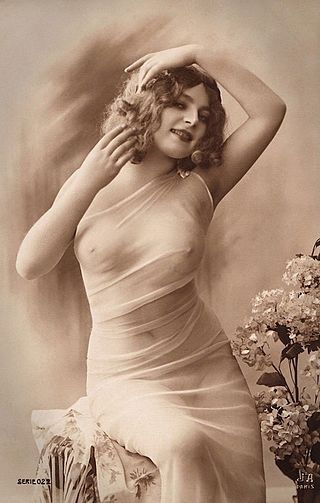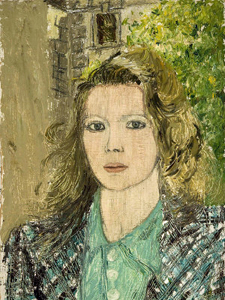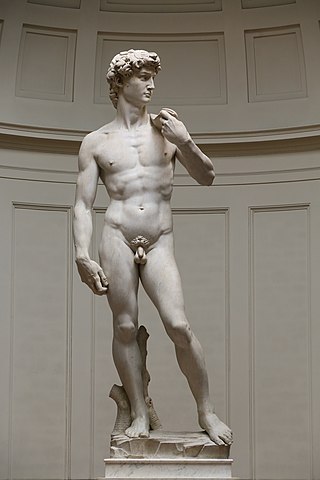Related Research Articles

Erotica is literature or art that deals substantively with subject matter that is erotic, sexually stimulating or sexually arousing. Some critics regard pornography as a type of erotica, but many consider it to be different. Erotic art may use any artistic form to depict erotic content, including painting, sculpture, drama, film or music. Erotic literature and erotic photography have become genres in their own right. Erotica also exists in a number of subgenres including gay, lesbian, women's, bondage, monster and tentacle erotica.

Erotic art is a broad field of the visual arts that includes any artistic work intended to evoke arousal. It usually depicts human nudity or sexual activity, and has included works in various visual mediums, including drawings, engravings, films, paintings, photographs, and sculptures. Some of the earliest known works of art include erotic themes, which have recurred with varying prominence in different societies throughout history. However, it has also been widely considered taboo, with either social norms or laws restricting its creation, distribution, and possession. This is particularly the case when it is deemed pornographic, immoral, or obscene.

Alice Neel was an American visual artist, who was known for her portraits depicting friends, family, lovers, poets, artists, and strangers. Her career spanned from the 1920s to 1980s. Her paintings have an expressionistic use of line and color, psychological acumen, and emotional intensity. She pursued a career as a figurative painter during a period when abstraction was favored, and she did not begin to gain critical praise for her work until the 1960s.
Jennifer Anne Saville is a contemporary British painter and an original member of the Young British Artists. Saville works and lives in Oxford, England and she is known for her large-scale painted depictions of nude women. Saville has been credited with originating a new and challenging method of painting the female nude and reinventing figure painting for contemporary art. Some paintings are of small dimensions, while other are of much larger scale. Monumental subjects come from pathology textbooks that she has studied that informed her on injury to bruise, burns, and deformity. John Gray commented: "As I see it, Jenny Saville's work expresses a parallel project of reclaiming the body from personality. Saville worked with many models who under went cosmetic surgery to reshape a portion of their body. In doing that, she captures "marks of personality for the flesh" and together embraces how we can be the writers of our own lives."

Carolee Schneemann was an American visual experimental artist, known for her multi-media works on the body, narrative, sexuality and gender. She received a B.A. in poetry and philosophy from Bard College and a Master of Fine Arts from the University of Illinois. Originally a painter in the Abstract Expressionist tradition, Schneeman was uninterested in the masculine heroism of New York painters of the time and turned to performance-based work, primarily characterized by research into visual traditions, taboos, and the body of the individual in relation to social bodies. Although renowned for her work in performance and other media, Schneemann began her career as a painter, saying: "I'm a painter. I'm still a painter and I will die a painter. Everything that I have developed has to do with extending visual principles off the canvas." Her works have been shown at the Los Angeles Museum of Contemporary Art, the Museum of Modern Art in New York, the London National Film Theatre, and many other venues.

Sylvia Sleigh was a Welsh-born naturalised American realist painter who lived and worked in New York City. She is known for her role in the feminist art movement and especially for reversing traditional gender roles in her paintings of nude men, often using conventional female poses from historical paintings by male artists like Diego Vélazquez, Titian, and Jean-Auguste-Dominique Ingres. Her most well-known subjects were art critics, feminist artists, and her husband, Lawrence Alloway.

Feminist art is a category of art associated with the feminist movement of the late 1960s and 1970s. Feminist art highlights the societal and political differences women experience in their lives. The goal of this art form is to bring a positive and understanding change to the world, leading to equality or liberation. Media used range from traditional art forms, such as painting, to more unorthodox methods such as performance art, conceptual art, body art, craftivism, video, film, and fiber art. Feminist art has served as an innovative driving force toward expanding the definition of art by incorporating new media and a new perspective.

The nude, as a form of visual art that focuses on the unclothed human figure, is an enduring tradition in Western art. It was a preoccupation of Ancient Greek art, and after a semi-dormant period in the Middle Ages returned to a central position with the Renaissance. Unclothed figures often also play a part in other types of art, such as history painting, including allegorical and religious art, portraiture, or the decorative arts. From prehistory to the earliest civilizations, nude female figures were generally understood to be symbols of fertility or well-being.

Orshi Drozdik is a feminist visual artist based in New York City. Her work consists of drawings, paintings, photographs, etchings, performances, videos, sculptures, installations, academic writings and fiction, that explore connected themes, sometimes over an extended period. Through her work, organized into several topics, she explores themes that undermine the traditional and erotic representation of women: Individual Mythologies,Adventure in Tecnos Dystopium, and Manufacturing the Self. She is influenced by Valéria Dienes, János Zsilka, Susan Sontag, Ludwig Wittgenstein, Luce Irigaray, Walter Benjamin, and Michel Foucault, among others. Her working method: critical analysis of meaning, influenced her contemporaries, her students and later generations of women artists. The art historian László Beke noted in an interview realized by Kata Krasznahorkai in 2017 that "Orsolya Drozdik is the first feminist artist in Hungary".

Miriam Schapiro was a Canadian-born artist based in the United States. She was a painter, sculptor, printmaker, and a pioneer of feminist art. She was also considered a leader of the Pattern and Decoration art movement. Schapiro's artwork blurs the line between fine art and craft. She incorporated craft elements into her paintings due to their association with women and femininity. Schapiro's work touches on the issue of feminism and art: especially in the aspect of feminism in relation to abstract art. Schapiro honed in her domesticated craft work and was able to create work that stood amongst the rest of the high art. These works represent Schapiro's identity as an artist working in the center of contemporary abstraction and simultaneously as a feminist being challenged to represent women's "consciousness" through imagery. She often used icons that are associated with women, such as hearts, floral decorations, geometric patterns, and the color pink. In the 1970s she made the hand fan, a typically small woman's object, heroic by painting it six feet by twelve feet. "The fan-shaped canvas, a powerful icon, gave Schapiro the opportunity to experiment … Out of this emerged a surface of textured coloristic complexity and opulence that formed the basis of her new personal style. The kimono, fans, houses, and hearts were the form into which she repeatedly poured her feelings and desires, her anxieties, and hopes".
SOHO20 Artists, Inc., known as SOHO20 Gallery, was founded in 1973 by a group of women artists intent on achieving professional excellence in an industry where there was a gross lack of opportunities for women to succeed. SOHO20 was one of the first galleries in Manhattan to showcase the work of an all-woman membership and most of the members joined the organization as emerging artists. These artists were provided with exhibition opportunities that they could not find elsewhere.
Anita Slavin Arkin Steckel was an American feminist artist known for paintings and photomontages with sexual imagery. She was also the founder of the arts organization "The Fight Censorship Group", whose other members included Hannah Wilke, Louise Bourgeois, Judith Bernstein, Martha Edelheit, Eunice Golden, Juanita McNeely, Barbara Nessim, Anne Sharpe and Joan Semmel.
Judith Bernstein is a New York artist best known for her phallic drawings and paintings. Bernstein uses her art as a vehicle for her outspoken feminist and anti-war activism, provocatively drawing psychological links between the two. Her best-known work features her iconic motif of an anthropomorphized screw, which has become the basis for a number of allegories and visual puns. During the beginning of the Feminist Art Movement, Bernstein was a founding member of the all-women's cooperative A.I.R. Gallery in New York.
Aleah Chapin is an American painter whose direct portrayals of the human form have expanded the conversation around western culture’s representations of the body in art. Described by Eric Fischl as “the best and most disturbing painter of flesh alive today,” Chapin’s work has explored aging, gender and beauty, influenced in part by the community within which she was raised on an island in the Pacific Northwest. More recently, Chapin's work has taken a radically inward shift, expanding her visual language in order to better express the turbulent times we are living in. Consistent throughout her career, Chapin’s work asks the question: What does it mean to exist within a body today?

Joan Semmel is an American feminist painter, professor, and writer. She is best known for her large-scale naturalistic nude self portraits as seen from her perspective looking down.
Shirley Gorelick was an American figurative painter, printmaker, and sculptor. She "rejected both the extremes of nonobjectivity and photographic exactitude," choosing instead to use a range of sources that included photographs, live models, and her own sculpted life studies.
Juanita McNeely was an American feminist artist known for her bold works that illustrate the female experience in her nude figurative paintings, prints, paper cut-outs, and ceramic pieces. Feminist emotional elements in her work include the portrayal of female experiences such as abortion, rape, and menstruation. Her recurring health problems and expressive figurative compositions have prompted comparisons to Frida Kahlo. According to McNeely, "we as women must continue the struggle to hold on to our rights, or let the children lead the way."
Diana Kurz is an Austrian-born feminist painter who is known for her Remembrance (Holocaust) series, which explores the "loss and preservation" of the artist’s family members during the Holocaust.
Eunice Golden is an American feminist painter from New York City, known for exploring sexuality using the male nude. Her work has been shown at the Whitney Museum of American Art, Brooklyn Museum, Bronx Museum of the Arts, Westbeth Gallery, and SOHO20 Gallery.
Clarity Haynes is a queer feminist American artist and writer. She currently lives and works in New York, NY. Haynes is best known for her unconventional painted portraits of torsos, focusing on queer, trans, cis female and nonbinary bodies. She is a former member of the tART Collective and the Corpus VI Collective.
References
- 1 2 Burt, Eugene C. (2010). Dictionary of Erotic Art. London: McFarland and Company, Inc. p. 97. ISBN 978078644874-6.
- 1 2 Love, Barbara J. (2006). Feminists who Changed America, 1963-1975 . Urbana and Chicago: University of Illinois Press. pp. 130. ISBN 978-0252031892.
- ↑ Middleman, Rachel (2014-04-08). "A Feminist Avant-Garde: Martha Edelheit's "Erotic Art" in the 1960s". Konsthistorisk Tidskrift. 83 (2): 129–147. doi:10.1080/00233609.2014.901413. S2CID 191577484.
- 1 2 "What to See in New York Art Galleries This Week". The New York Times. 2018-11-07. ISSN 0362-4331 . Retrieved 2020-04-10.
She also studied with the distinguished art historian, Meyer Schapiro, at Columbia University. - Inventing Downtown: Artist-Run Galleries in New York City, 1952-1965
- 1 2 Middleman, Rachel (2018). Radical Eroticism: Women, Art, and Sex in the 1960s. University of California Press. pp. 65–66. ISBN 9780520294585.
- ↑ Mannarino, Chiara (2021-11-29). "Martha Edelheit's 'Flesh Walls': towards a communal, queer futurity". Burlington Contemporary Journal (5). doi:10.31452/bcj5.edelheit.mannarino. ISSN 2631-5661. S2CID 244768568.
- ↑ Middleman, Rachel (3 April 2014). "A Feminist Avant-Garde: Martha Edelheit's 'Erotic Art' in the 1960s". Konsthistorisk Tidskrift/Journal of Art History. 83 (2): 129–147. doi:10.1080/00233609.2014.901413. S2CID 191577484.
- ↑ Hottle, Andrew D. (2014). The Art of the Sister Chapel: Exemplary Women, Visionary Creators, and Feminist Collaboration. Farnham, England: Ashgate Publishing Ltd. pp. 229–242.
- ↑ Johnston, Laurie (1978-01-30). "The 'Sister Chapel': A Feminist View of Creation". The New York Times. ISSN 0362-4331 . Retrieved 2020-04-10.
- ↑ Hats, Bottles and Bones: A Portrait of Sari Dienes Movie Review, date: 1977, collection: Museum of Modern Art (MOMA) circulating film & video library
- ↑ Malarcher, Patricia (1984-09-23). "Crafts; Odds and Ends in Art and Life". The New York Times. ISSN 0362-4331 . Retrieved 2020-04-10.
- ↑ "Action, Gesture, Paint". Whitechapel Gallery. Retrieved 16 April 2023.
- 1 2 3 Richard Meyer, "Hard Targets: Male Bodies, Feminist Art, and the Force of Censorship in the 1970s," in WACK! Art and the Feminist Revolution (Los Angeles: Museum of Contemporary Art, 2007), 362–383.
- ↑ Carol Jacobsen, "Redefining Censorship: A Feminist View," Art Journal 50, no.4 (Winter 1991): 42–55.
- ↑ "Associates | The Women's Institute for Freedom of the Press". www.wifp.org. Retrieved 2017-06-21.
- ↑ "Some Living American Women Artists/Last Supper". Smithsonian American Art Museum. Retrieved 25 January 2022.
- ↑ "Wennman meets Sam Nilsson". Aftonbladet. Dec 21, 1999. Retrieved Apr 5, 2014.
- ↑ Lund Ek, Helena (March 11, 2020). "Being an artist was sort of like being god". Kunstkritikk, Nordic Art Review. Retrieved Mar 6, 2021.